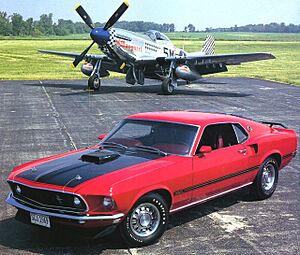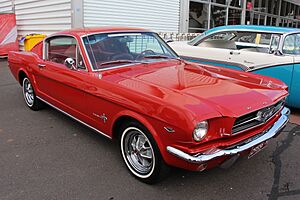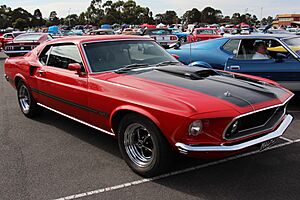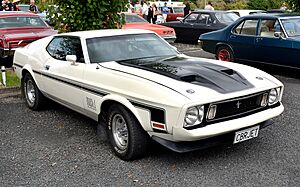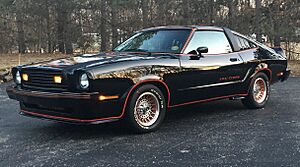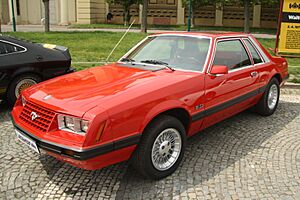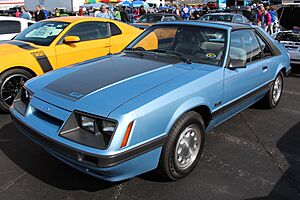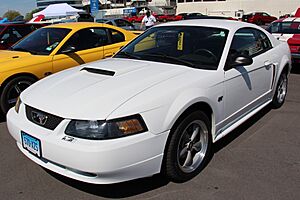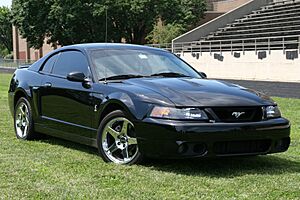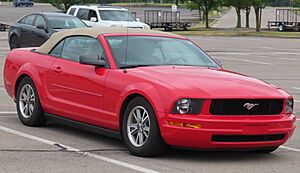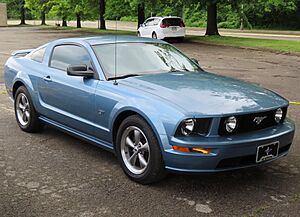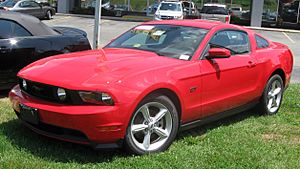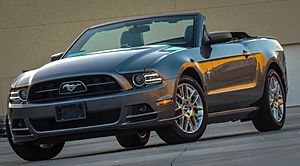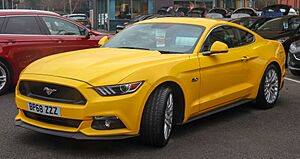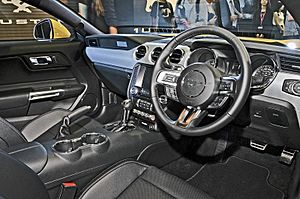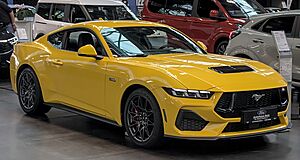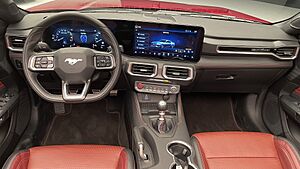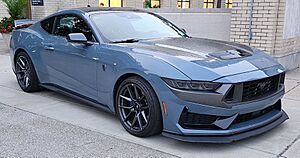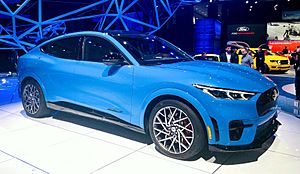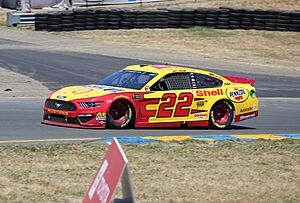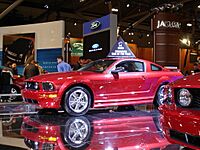Ford Mustang facts for kids
Quick facts for kids Ford Mustang |
|
|---|---|
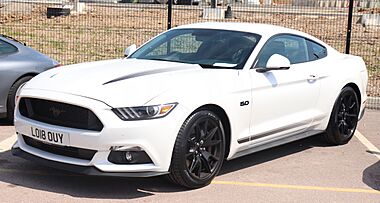
2018 Ford Mustang GT 5.0
|
|
| Overview | |
| Manufacturer | Ford |
| Also called | Ford T5 |
| Production | March 1964 – present |
| Model years | 1965–present |
| Body and chassis | |
| Class |
|
| Body style |
|
| Layout | FR layout |
The Ford Mustang is a super famous American car made by Ford. It's been made non-stop since 1964, making it Ford's longest-running car name. Right now, it's in its seventh version and is one of Ford's top-selling cars.
The Mustang gave its name to a type of car called a "pony car". These cars are sporty coupes and convertibles with a special look: a long front (hood) and a short back (deck).
When it first came out, Ford thought they'd sell about 100,000 Mustangs each year. But the 1965 Mustang was a huge hit! It was the most successful car launch since the 1927 Model A. It was shown on April 17, 1964. In its first year, over 400,000 Mustangs were sold. Just two years after it launched, Ford sold the one-millionth Mustang! In August 2018, Ford made the 10-millionth Mustang. It was a white convertible, just like the very first 1965 model.
The Mustang's success made other car companies want to make similar cars. This included the Chevrolet Camaro and Pontiac Firebird (1967), AMC Javelin (1968), and Dodge Challenger (1970). It also competed with the Plymouth Barracuda, which came out around the same time. The Mustang also influenced car designs all over the world. This led to cars like the Toyota Celica and Ford Capri being sold in the United States.
For many years, from 1965 to 2004, the Mustang shared parts with other Ford cars. It always kept its rear-wheel-drive system. Since 2005, Ford has made two new versions of the Mustang. Each one uses a special platform (the car's basic structure) made just for the Mustang.
Over the years, many different versions of the Ford Mustang have been made. Some popular names include GT, Mach 1, Boss, Cobra, and Bullitt. You might also see "5.0" on the side, which means it has a powerful V8 engine.
Contents
- What's in a Name?
- First Generation (1965-1973)
- Second Generation (1974-1978)
- Third Generation (1979-1993)
- Fourth Generation (1994-2004)
- Fifth Generation (2005-2014)
- Sixth Generation (2015-2023)
- Seventh Generation (2024-Present)
- Mustang Mach-E
- Racing History
- Awards
- Sales Numbers
- Mustang Owner's Museum
- See also
What's in a Name?
A Ford designer named John Najjar loved the P-51 Mustang fighter plane from World War II. Ford says he suggested the name "Mustang" for the car. John Najjar helped design the very first Mustang idea car in 1961. This car, called the "Ford Mustang I", was shown on October 7, 1962. A famous race car driver, Dan Gurney, even drove it around a track!
Another story says that Robert J. Eggert, a Ford market researcher, first thought of the name. He raised quarterhorses (a type of horse). His wife gave him a book called The Mustangs in 1960. This book gave him the idea for the car's name. Other designers liked names like Cougar or Torino. Even Henry Ford II wanted to call it T-bird II. But when Ford asked groups of people what name they liked best, "Mustang" won by a lot!
However, the name "Mustang" couldn't be used in Germany. Another company already owned it there. So, Mustangs were sold in Germany as "T-5s" until 1978.
First Generation (1965-1973)
Lee Iacocca was a big leader at Ford. His assistant, Donald N. Frey, was the main engineer for the first Mustang project. They developed the car very quickly, in just 18 months! The first Mustang idea car was a two-seater. But it later became a four-seater concept car in 1963. This was to see if people would like the car before it was made for sale.
The first Mustang was based on the Ford Falcon, which was a smaller car. This helped Ford build the Mustang quickly and keep its price low.
The "1964½" Mustang
The Ford Mustang started being made five months before the usual start of the 1965 car year. These early cars are often called "1964½ models." But Ford officially called all of them 1965 models.
Production started on March 9, 1964. The first Mustang was sold to the public on April 14, 1964, in Canada. It was officially shown at the 1964 New York World's Fair on April 17, 1964. At first, you could buy it as a two-door hardtop or a convertible. A "2+2" fastback (a car with a sloped back roof) was added later in 1964.
The Mustang even appeared in James Bond movies! A white convertible was in Goldfinger in 1964. A turquoise coupe was in Thunderball in 1965.
The day after the car was officially shown, 2,600 newspapers wrote good things about it. The Mustang was a four-seat car with comfortable front seats and a back bench seat. The fastback version, made starting in August 1964, had a sleek, sloped roofline.
Low Price and Huge Sales
Ford wanted the Mustang to be affordable, costing around $2,368 in 1965. To do this, they used many simple parts that were already being made for other Ford cars like the Falcon and Fairlane. This also made it easier for workers to build the car and for dealers to fix it.
Ford thought they would sell less than 100,000 Mustangs in the first year. But they sold that many in just three months! Another 318,000 were sold that year, setting a record. In its first 18 months, over one million Mustangs were built!
Updates and Changes
Ford made some changes to the Mustang starting in August 1964. Some models got back-up lights. The car's electrical system was updated. The six-cylinder engine got more power, going from 101 to 120 horsepower. The V8 engine also got more power, from 164 to 210 horsepower. These early versions, with their small differences, are still called "1964½" Mustangs by car fans.
Even as the first Mustang was selling well, designers started making bigger versions. From 1967 to 1973, the Mustang grew in size. This allowed Ford to offer a very large engine for the first time. The front and back of the car looked bolder. New safety rules in 1967 meant the Mustang got a safer steering wheel and column, emergency flashers, and better brakes. In 1968, side marker lights were added, and front shoulder belts became standard. A new V8 engine was also introduced in 1968.
The 1969 Mustang looked even bigger and more aggressive. It had "quad headlamps" (four headlights) that year. For 1970, the headlights went back to the standard two, and the front looked a bit less aggressive.
Special Models
Starting in 1969, Ford offered many new options for the Mustang. These included air scoops, hood tie-downs, and spoilers. Several special performance versions were also introduced:
- The Mach 1
- The Boss 302
- The Boss 429
The Boss models were made to help Ford race those engines. The GT option was stopped after 1969, but it came back later. A new model called the Grandé was also popular. It was a hardtop with a smooth ride, fancy trim, and extra soundproofing.
The Mustang kept getting bigger from 1971 to 1973. It gained about 800 pounds! This made the car feel "fat and lazy" to some people. The SportsRoof models had a very flat rear roofline, which made it hard for the driver to see. Sales started to drop as people wanted smaller, more fuel-efficient cars like the Ford Pinto. Lee Iacocca, a key person behind the Mustang, later said, "The Mustang market never left us, we left it."
Second Generation (1974-1978)
In 1970, Lee Iacocca became the president of Ford. He wanted a smaller, more fuel-efficient Mustang for 1974. This new Mustang, called the "Mustang II," was based on the smaller Ford Pinto car.
The Mustang II came out on September 21, 1973, just before the 1973 oil crisis. Its smaller size helped it compete with popular imported sports cars from Japan and Europe. In its first year, 385,993 Mustang IIs were sold. This was almost as many as the original Mustang's first-year record! The Mustang II was an early example of car companies making cars smaller to save fuel.
Iacocca wanted the new Mustang II to be a "little jewel." It was smaller than the original Mustang but also heavier. This was because of new equipment needed to meet U.S. rules for emissions and safety. The car's performance was not as strong as before.
For 1974, the Mustang II had a 2.3-liter four-cylinder engine or a 2.8-liter V6 engine. In 1975, the powerful 5.0-liter V8 engine came back! This V8 was available until 1978.
The Mustang II was sold as a coupe or a hatchback. There was also a fancy "Ghia" model with a padded vinyl roof. Other special versions included the "Mach 1," "Cobra II" (1976–1978), and "King Cobra" (1978). In 1977 and 1978, you could even get hatchback models with a T-top roof, which had removable glass panels.
Third Generation (1979-1993)
The 1979 Mustang was built on a larger base called the Fox platform. This new design gave the car more space inside for passengers and a bigger trunk. The engine area was also larger.
You could get the third-generation Mustang as a coupe (notchback), a hatchback, or a convertible (starting in 1983). Many different versions were available, like the Cobra, GT, LX, and the special SVO model.
The engines from the Mustang II were used at first. But they were soon replaced with newer, more powerful ones. A turbocharged four-cylinder engine was available for a while. The 5.0-liter V8 engine, known for its power, returned in 1982.
From 1979 to 1986, Ford also made a car called the Mercury Capri. It was a Mercury version of the Mustang with its own unique look.
The third-generation Mustang had two main front-end styles. From 1979 to 1986, it had four rectangular headlights, which fans called "four eyes." For 1987 to 1993, the front was updated to a smoother, more rounded "aero" style with modern headlights.
The Mustang was chosen as the official pace car for the 1979 Indianapolis 500 race. Special versions of this car were sold to the public.
In 1982, the Mustang GT model came back. It had a specially tuned 5.0-liter engine. The convertible model returned in 1983 after being gone for nine years. Also in 1983, all Mustangs got new grilles with the blue Ford oval emblem.
The high-performance Mustang SVO was introduced in 1984. It had a turbocharged four-cylinder engine and a unique body. In 1984, the Mustang also celebrated its 20th birthday with a special GT350 model.
In the 1980s, Ford thought about making a new Mustang based on a Mazda car, which would have been front-wheel drive. But Mustang fans wrote to Ford, saying they wanted the traditional rear-wheel-drive Mustang with a V8 engine. So, Ford decided to keep the existing Mustang design. The Mazda-based car was instead named the Ford Probe.
The Mustang got a big update in 1987, including a new interior. This style lasted until 1993. In 1993, Ford's special SVT division made high-performance Mustang SVT Cobra and Cobra R models.
Fourth Generation (1994-2004)
In November 1993, the Mustang got its first major new design in 15 years. This version was called "SN95" by Ford. It used an updated version of the Fox platform. The new look took ideas from older Mustangs. For the first time, there was no "notchback" coupe model.
The basic Mustang model came with a 3.8-liter V6 engine. It had 145 horsepower in 1994 and 1995, and 150 horsepower from 1996 to 1998. It came with a 5-speed manual or an optional 4-speed automatic transmission.
Ford stopped using the old 5.0-liter V8 engine after almost 30 years. In 1996, the Mustang GT got a newer 4.6-liter V8 engine. This engine first had 215 horsepower, then 225 horsepower in 1998.
For 1999, the Mustang got a fresh new look with sharper lines and bigger wheel arches. But its basic shape and inside design stayed the same. The engines were improved. The V6 engine now had 190 horsepower. The GT's 4.6-liter V8 engine got a boost to 260 horsepower. In 2004, a slightly larger 3.9-liter V6 replaced the 3.8-liter.
There were also three special models in this generation:
- The 2001 Bullitt
- The 2003 and 2004 Mach 1
- The powerful Cobra (with 320 horsepower in 1999/2001 and 390 horsepower in 2003/2004)
Fifth Generation (2005-2014)
Ford showed off a new Mustang design for the 2005 model year. This car, called "S197," was based on a new platform. Its look was inspired by the classic fastback Mustangs from the late 1960s. Ford called this style "retro-futurism." The fifth-generation Mustang was built in Flat Rock, Michigan.
From 2005 to 2010, the basic Mustang had a 4.0-liter V6 engine with 210 horsepower. The GT model used a 4.6-liter V8 engine with 300 horsepower. Both models came with a 5-speed manual or a 5-speed automatic transmission.
In 2007, Ford's SVT launched the Shelby GT500. This was a very powerful car with a supercharged 5.4-liter V8 engine. It made 500 horsepower!
The 2010 Mustang got a new look on the outside, including cool LED taillights. The GT's 4.6-liter V8 engine was updated to 315 horsepower. The car also got new suspension parts and safety features like traction control.
For 2011, the engines were changed again. The V6 model got a new 3.7-liter V6 engine with 305 horsepower. The GT models got a powerful 5.0-liter V8 engine (called the "Coyote") with 412 horsepower! You could also get special Brembo brakes and larger wheels.
In 2012, a new Mustang Boss 302 version was introduced. Its engine had 444 horsepower. A "Laguna Seca" edition was also available. This version was made for racing and had extra parts to make it stiffer and handle better.
Ford updated the Mustang again in 2012 for the 2013 model year. The Shelby GT500 got a new 5.8-liter supercharged V8 engine with an amazing 662 horsepower! The GT and V6 models got updated styling. The GT's 5.0-liter V8 engine also gained a little more power, reaching 420 horsepower.
Sixth Generation (2015-2023)
The sixth-generation Mustang was shown on December 5, 2013, in several cities around the world. It was called "S550" inside Ford.
This new Mustang was wider and lower than before. It had a new grille and new colors. The inside had more space. Three engine options were available:
- A new 2.3-liter EcoBoost four-cylinder engine with 310 horsepower (made for global markets like China).
- A 3.7-liter V6 engine with 300 horsepower.
- A 5.0-liter Coyote V8 engine with 435 horsepower.
You could choose a six-speed manual or a six-speed automatic transmission. A big change for this generation was a new independent rear suspension system. This helped the car handle better. It was also the first Mustang designed from the factory to be sold in countries where people drive on the right side of the road.
In 2015, the Mustang got a five-star safety rating from the U.S. National Highway Traffic Safety Administration (NHTSA). However, in Europe, the 2017 Mustang only received two stars in crash tests. This was because it lacked some modern safety features like lane assist and automatic braking.
The 2018 Mustang got a small update to its look. The 3.7-liter V6 engine was removed. The 2.3-liter EcoBoost four-cylinder engine became the standard engine, making 310 horsepower. The 5.0-liter V8 engine in the GT got a power boost to 460 horsepower! Both engines could now be paired with a new ten-speed automatic transmission. In 2018, Ford also showed a special 2018 Bullitt model. This car celebrated the 50th anniversary of the movie Bullitt, which featured a famous Mustang.
For 2019, the Shelby GT350 got updates to its tires, steering, and suspension. The 2020 model year brought back the powerful GT500. The 2020 GT500 had a hand-built 5.2-liter V8 engine with a supercharger. It produced an incredible 760 horsepower! The GT350 model was stopped at the end of 2020.
For 2021, the Mach 1 model returned after 17 years. The 2021 Mach 1 uses the 5.0-liter Coyote engine. It also uses parts from the GT350 and GT500 to boost its performance to 480 horsepower.
Seventh Generation (2024-Present)
Ford showed the seventh-generation Mustang on September 14, 2022. This new model, called "S650," also introduced a new "Dark Horse" series. The Dark Horse is a street-legal car with even better performance for racing on tracks.
The seventh-generation Mustang started being made on May 1, 2023. At launch, you could get it with:
- A redesigned 2.3-liter EcoBoost turbocharged four-cylinder engine with 315 horsepower.
- A revised, fourth-generation Coyote V8 engine. This engine makes 480-486 horsepower in the GT and 500 horsepower in the Dark Horse.
You can choose from a 6-speed manual transmission (for GT and Dark Horse) or a 10-speed automatic transmission.
Mustang Mach-E
On November 17, 2019, Ford announced the Ford Mustang Mach-E. This car is very different from the traditional Mustang. It's an electric crossover vehicle. It can be rear-wheel drive or all-wheel drive. It has a long driving range on a single charge and a modern Ford Sync system with a large screen.
The Mach-E comes in different versions like First Edition, Select, and GT. Even though it shares the Mustang name and badge, it's a separate model. It's not counted as one of the main Mustang generations. It's an electric car built on a different platform.
Racing History
The Mustang first appeared on a racetrack as the pace car for the 1964 Indianapolis 500 race.
In 1964, Mustangs won first and second place in their class at the Tour de France international rally. In 1969, special Mustang models set 295 records at the Bonneville Salt Flats. They even drove for 24 hours straight at an average speed of 157 miles per hour!
Drag Racing
The Mustang first raced in America in 1964 in drag racing. Private teams and Ford-sponsored teams raced Mustangs with powerful V8 engines. In 1965, special 427-powered Mustangs raced in the NHRA Winternationals. A Mustang driven by Bill Lawton won its class.
Years later, Bob Glidden won the Mustang's first NHRA pro stock title. John Force set a record in 2002 by winning his 12th national championship in his Ford Mustang funny car. He broke that record again in 2006, becoming a 14-time champion!
Circuit Racing
Early Mustangs were also great at road racing. The GT 350 R, a race version of the Shelby GT 350, won many races in 1965. It won the B-Production national championship in 1965, 1966, and 1967. Mustangs also won the Trans-Am series championship in 1966 and 1967. In 1970, Mustang won the SCCA series championship again.
In 1975, Ron Smaldone's Mustang was the first American car to win the Showroom Stock national championship in SCCA road racing. Mustangs also did well in IMSA GTO races, winning in 1984 and 1985. In 1985, Ford won its first manufacturers' championship in road racing since 1970.
In 1987, Saleen Autosport Mustangs won the SCCA Escort Endurance SSGT championship. In 1989, the Mustang won Ford its first Trans-Am championship since 1970.
Mustangs still race in the SCCA World Challenge. Ford also won championships in the Grand-Am Road Racing series in 2005, 2008, and 2009 with the Mustang FR500C and GT models. In 2012, a Mustang Boss 302R won a race at Daytona.
In 2016, the S550-based Shelby GT350R-C won drivers' and manufacturers' titles in IMSA racing. On July 27, 2023, Ford announced a new Mustang Challenge racing series for the 7th Generation Mustang.
Stock Car Racing
In 1972, Dick Trickle won 67 short-track oval races, a U.S. record for wins in one season.
In 2010, the Ford Mustang became Ford's car for the NASCAR Nationwide Series. Full-time racing of the Mustang began in 2011. These NASCAR cars don't look exactly like the street Mustangs, but they have decals that make them look similar. Carl Edwards won the first NASCAR race with a Mustang on April 8, 2011. Ford Mustangs have also raced in the NASCAR Xfinity Series since 2010. They also race in the NASCAR Whelen Euro Series.
Since 2019, Ford Mustangs have been racing in the top NASCAR Cup Series, replacing the Ford Fusion.
Drifting
Mustangs have competed in drifting series like Formula Drift. Famous American driver Vaughn Gittin Jr. often drives a Mustang. Brazilian driver Diego Higa won the Netflix Hyperdrive Series in 2019 in a 2006 Ford Mustang V8.
Europe and Australia
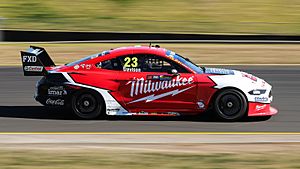
Ford Mustangs race in the FIA GT3 European Championship and other sports car races like the 24 Hours of Spa.
In Australia, the Ford Mustang replaced the Ford Falcon FG X in the 2019 Supercars Championship. The Mustang won the first race of the year with Scott McLaughlin driving.
Awards
The 1965 Mustang won the Tiffany Gold Medal for excellent American design. It was the first car ever to receive this award.
The Mustang has been on the Car and Driver Ten Best list many times, including in 1983, 1987, 1988, 2005, 2006, 2011, and 2016. It also won the Motor Trend Car of the Year award in 1974 and 1994.
Sales Numbers
|
|
|
|
|
|
|
Mustang Owner's Museum
In May 2016, plans for a Mustang Owner's Museum were announced. It officially opened in Concord, North Carolina, on April 17, 2019. This date was the 55th anniversary of the Mustang. The museum was built in Concord because of a very successful Mustang celebration there in 2014. Over 4,000 Mustangs attended, bringing a lot of money to the area.
See also
 In Spanish: Ford Mustang para niños
In Spanish: Ford Mustang para niños
- Ford Mustang variants
- California Special Mustang
- Ford Mustang SSP
- Ford Mustang Mach-E


